Ultimate Guide To Choosing The 25 Best Dog Food For Your Pet
Choosing the best dog food for your furry friend can be overwhelming. With countless options on the market, how do you know which one is right for your pup? I’ve spent years researching and testing different dog foods, and I’m here to help you make the best choice for your four-legged companion.
As a veterinary nutritionist with over a decade of experience, I’ve seen firsthand how proper nutrition can transform a dog’s health and happiness. In this guide, I’ll share my top picks for the 25 best dog foods, covering everything from dry kibble to raw diets. Ready to find the perfect chow for your canine pal?
Key Takeaways
- Quality dog food with real meat, veggies, and healthy fats keeps dogs healthy and happy.
- Check labels for protein (18%+ for adults, 22%+ for puppies), fat (5-8%), and fiber (2-4%).
- Look for AAFCO approval to ensure food meets nutritional guidelines for your dog’s life stage.
- Grain-free and limited ingredient diets can help dogs with allergies or sensitivities.
- Puppies and active dogs need more protein and calories, while senior dogs need joint support and easier-to-digest food.
Overview of the importance of proper nutrition for dogs.
Feeding our dogs the right food is super important. It’s not just about filling their bellies. Good food keeps them healthy and happy. I’ve seen firsthand how the right chow can make a dog’s coat shine and their eyes sparkle.
It’s like putting premium gas in a car – everything just runs better.
You are what you eat applies to our furry friends too!
Quality dog food has real meat, veggies, and good carbs. It’s packed with stuff dogs need, like protein for strong muscles and omega fatty acids for a glossy coat. I always check the label to make sure it meets AAFCO guidelines.
That’s my way of knowing it’s got all the right nutrients. Picking the best food for your pup is a big deal, but it’s worth it to see them thrive.
How the right dog food contributes to health and happiness.
I can’t stress enough how important good dog food is for your pup’s health and happiness. Picking the right chow does wonders for their energy, coat, and overall well-being. High-quality grub packed with real meat, veggies, and healthy extras like omega fatty acids keeps your furry friend in tip-top shape.
It’s not just about filling their belly – the right food helps prevent health issues and keeps their tail wagging.
Good nutrition is key to your dog’s quality of life. The best dog foods meet AAFCO guidelines and cater to your pet’s specific needs. Whether it’s puppy food for growth, senior food with joint support, or grain-free options for sensitive tummies, there’s something out there for every pooch.
Now, let’s dig into what makes up your dog’s nutritional needs.
Understanding Your Dog’s Nutritional Needs

Dogs need a mix of protein, fat, and carbs to stay healthy. Each pup is different, so their food needs can vary. Want to know more about what your furry friend needs? Keep reading!
The role of protein, fat, fiber, and carbohydrates in dog food.
I’ve learned that protein, fat, fiber, and carbs are the building blocks of good dog food. Protein helps build strong muscles and keeps your pup’s coat shiny. Fat gives them energy and helps absorb vitamins.
Fiber aids digestion and keeps your dog feeling full. Carbs provide quick energy for active dogs. I always check the label for high-quality meat as the first ingredient. It’s key to pick food with the right mix of these nutrients for your dog’s age and health needs.
Good dog food should have a balance of all these elements. I look for brown rice, sweet potatoes, and veggies like carrots in the ingredient list. These are great sources of healthy carbs and fiber.
Omega fatty acids are a bonus – they’re great for skin and coat health. Next, let’s talk about how to read those tricky dog food labels.
Specific nutritional needs based on life stage and health.
Now that we’ve covered the basics of dog food nutrients, let’s talk about how these needs change as your pup grows. I’ve seen firsthand how a dog’s diet needs to shift over time. Puppies need more calories and protein to fuel their rapid growth.
Adult dogs need a balanced diet to maintain their health. Senior dogs often need fewer calories but more fiber to help with digestion.
Health issues also play a big role in what your dog should eat. Dogs with joint problems might benefit from food with glucosamine. Overweight dogs may need low-fat options. I once had a dog with skin allergies, and switching to a limited ingredient diet made a world of difference.
It’s crucial to match your dog’s food to their specific needs. This way, you’re not just feeding them – you’re supporting their overall health and happiness.
How to Read a Dog Food Label
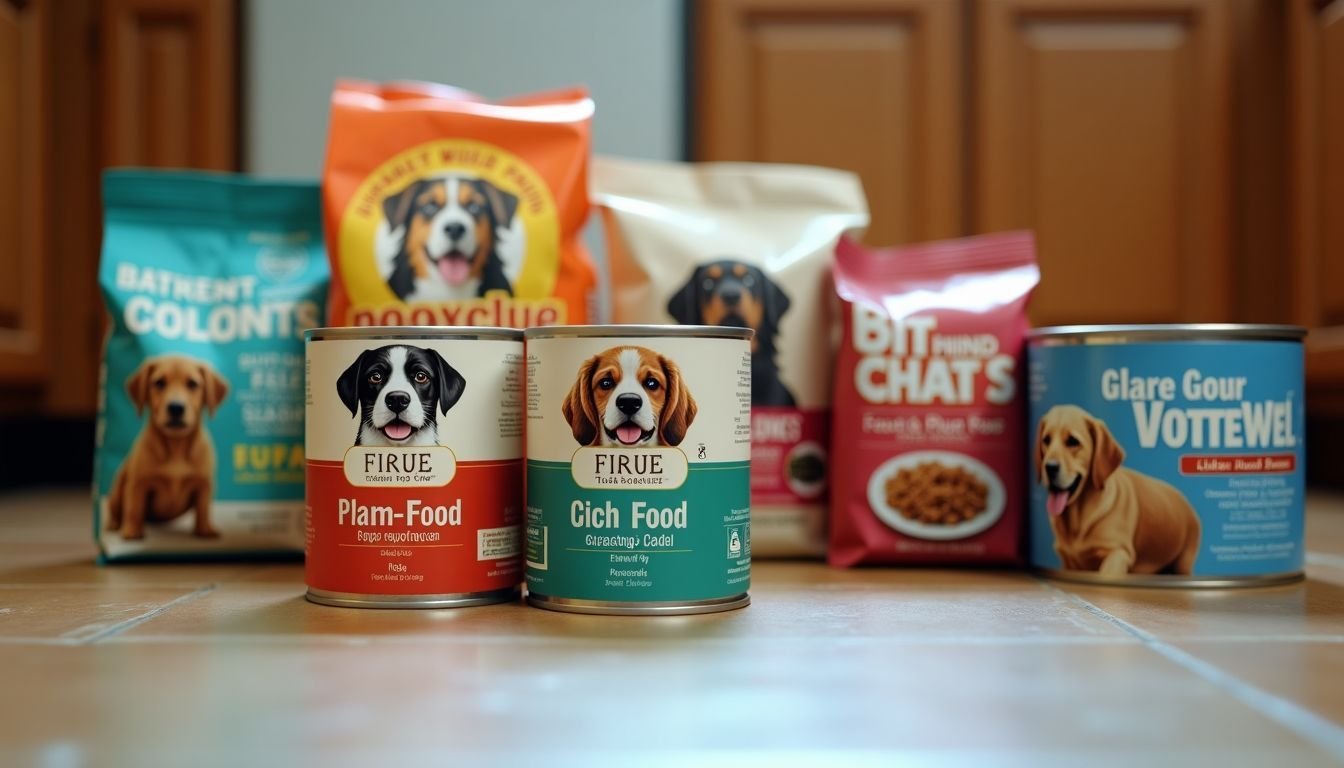
Reading dog food labels can be tricky. But it’s key to picking the right chow for your pup. Want to know what to look for? Keep reading to become a pro at decoding those labels!
Key components to look for: protein, fat, fiber, and ingredients.
I always check four key things on dog food labels: protein, fat, fiber, and ingredients. Protein is super important – it should be the first item listed and come from real meat sources.
I look for at least 18% protein for adult dogs and 22% for puppies. Fat gives dogs energy, so I aim for 5-8% for most pups. Fiber helps digestion, so I pick foods with 2-4%. The ingredients list tells me a lot too.
I want to see whole foods I recognize, not a bunch of fillers or artificial stuff.
When picking dog chow, I pay close attention to the nutritional adequacy statement. This tells me if it meets AAFCO guidelines for complete and balanced nutrition. I also look for healthy extras like omega fatty acids for skin and coat health.
Brown rice, sweet potatoes, and peas are good carb sources I like to see. At the end of the day, the best food depends on my dog’s specific needs. But focusing on these key components helps me choose a high-quality option to keep my furry friend happy and healthy.
Understanding the AAFCO guidelines.
AAFCO guidelines are crucial for pet owners like me. They set the bar for what goes into our furry friends’ food bowls. These rules make sure dog food has the right stuff to keep our pups healthy and happy.
I look for the AAFCO statement on every bag of kibble I buy. It tells me if the food meets basic nutritional needs for dogs.
But there’s more to it than just a stamp of approval. AAFCO guidelines cover different life stages, from puppies to senior dogs. They spell out what nutrients each age group needs.
This helps me pick the best food for my dog’s current stage of life. Now, let’s explore the topic of high-quality protein sources in dog food.
Best Dry Dog Food Options
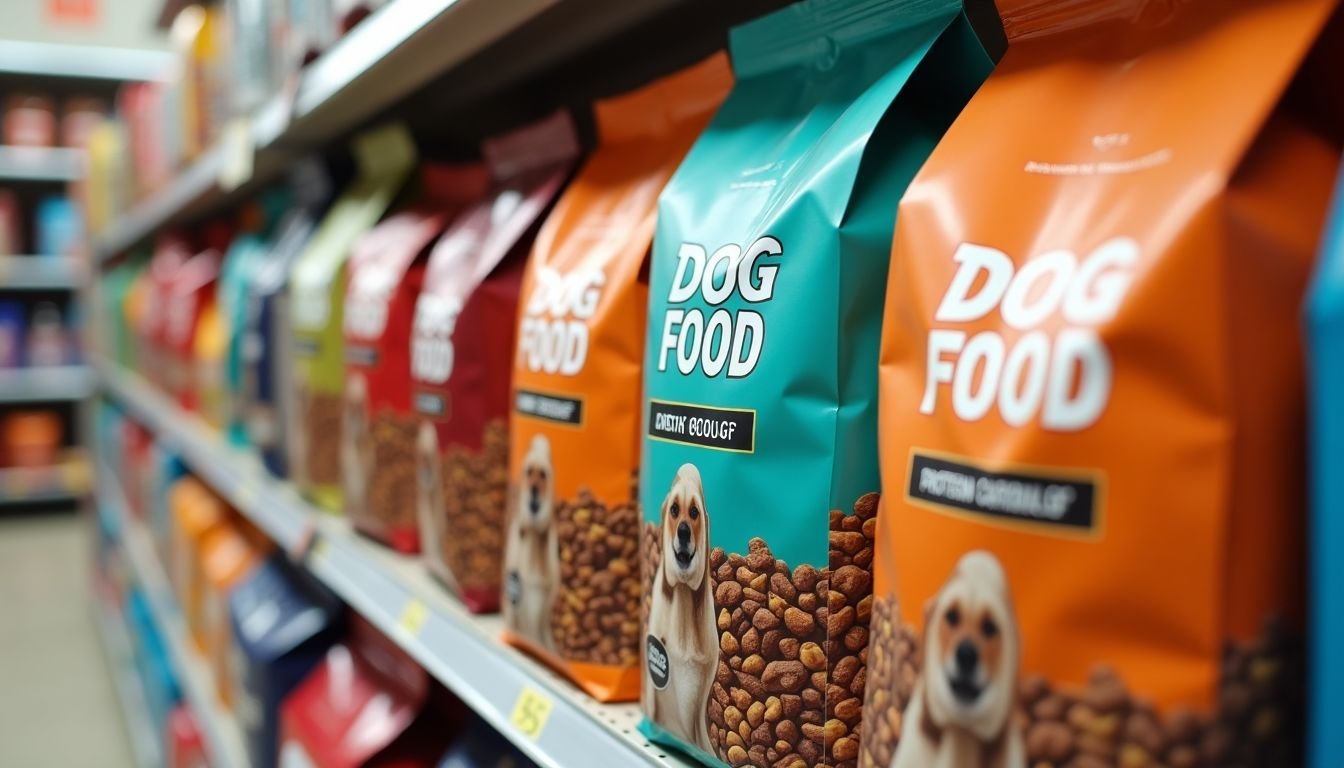
Dry dog food is a popular choice for many pet owners. It’s easy to store and often more affordable than wet food. But not all kibble is created equal. Some brands pack their food with fillers and low-quality ingredients.
Others use top-notch protein sources and balanced nutrients. Want to know which dry foods stand out from the pack? Keep reading to find out!
High-Quality Protein Dog Food (Chicken, Beef, or Fish)
I’ve found that high-quality protein dog food is a game-changer for our furry friends. It’s packed with meat like chicken, beef, or fish as the main ingredient. These proteins help build strong muscles and keep dogs healthy.
I always check the label to make sure real meat is listed first. It’s not just about quantity, though. The quality of the protein matters too.
Good protein sources give dogs the amino acids they need. They also taste great, which means even picky eaters will chow down. I’ve noticed my dog’s coat looks shinier since switching to a high-protein diet.
Plus, he seems to have more energy on our walks. It’s amazing what the right food can do for a dog’s health and happiness.
Grain-Free Dry Dog Food for sensitive dogs.
Grain-free dry dog food can be a game-changer for pups with sensitive tummies. I’ve seen many dogs thrive on these special kibbles. They swap out grains like wheat and corn for other carbs like sweet potatoes or peas.
This switch often helps dogs who get itchy or gassy from regular food. The best grain-free options pack in high-quality protein from real meat. They also add good fats and fiber to keep your furry friend feeling great.
But here’s the scoop – not all dogs need to go grain-free. It’s smart to chat with your vet before making the leap. They can help you pick the right food for your pup’s unique needs.
If you do go grain-free, keep an eye on your dog. Watch for any changes in their energy or coat. The goal is to find a food that makes your dog feel top-notch, whether it has grains or not.
Best Wet Dog Food Options
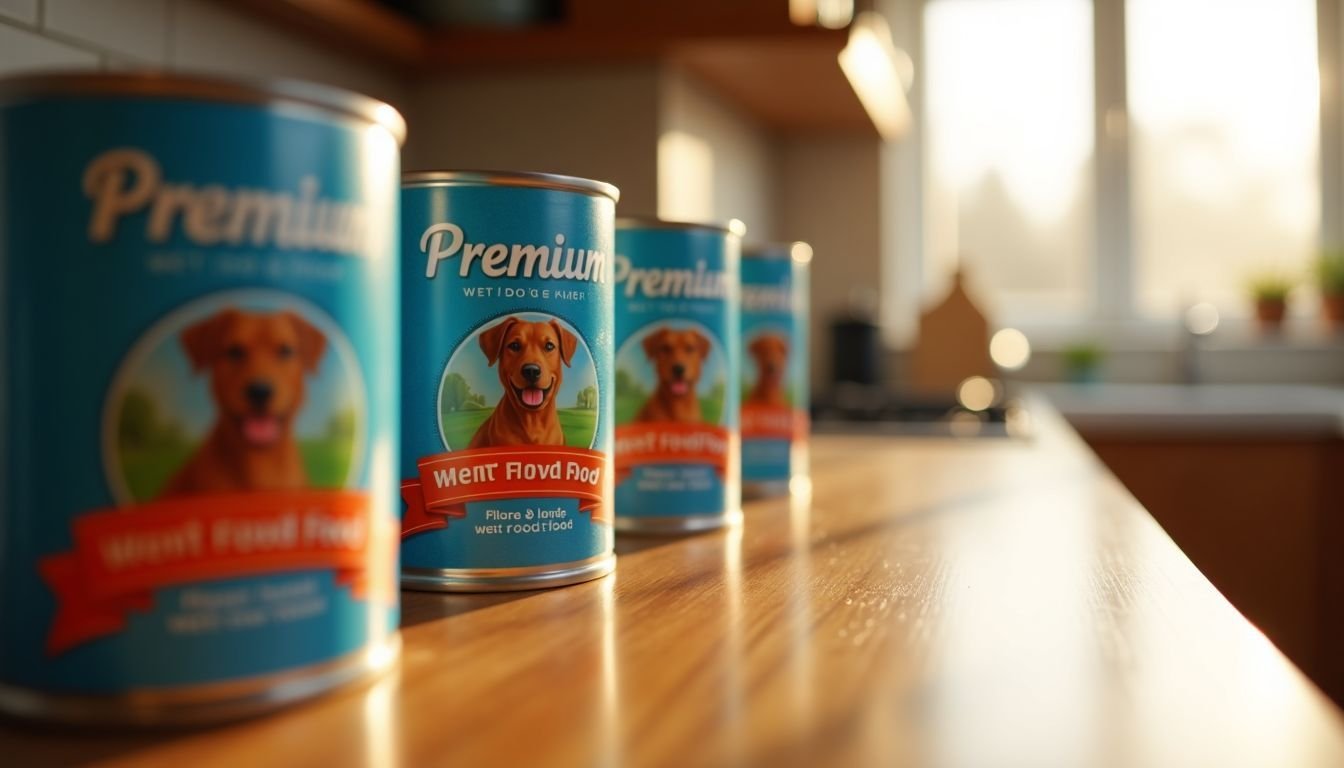
Wet dog food brings more flavor and moisture to your pup’s bowl. It’s great for picky eaters or dogs who need extra hydration. Want to know which brands top the list? Keep reading!
Canned Dog Food with Real Meat for added flavor and moisture
I love giving my pup canned dog food with real meat. It’s packed with flavor and moisture that dry kibble just can’t match. The chunks of beef, chicken, or fish make my dog’s tail wag like crazy at mealtime.
Plus, the extra water content helps keep him hydrated, which is great for his health.
Canned food with real meat is perfect for picky eaters too. The strong meaty smell and taste tempt even finicky dogs. I’ve found it mixes well with dry food to add variety. Just be sure to check the label for high-quality protein sources listed first.
A good canned food should have meat as the main ingredient, not fillers or by-products.
Low-Fat Wet Dog Food for weight management.
Low-fat wet dog food is a great choice for pups who need to shed a few pounds. These foods pack fewer calories but still keep your furry friend full and happy. I’ve found that many brands offer tasty options with lean proteins like chicken or fish.
They also include fiber-rich veggies to help your dog feel satisfied. The extra moisture in wet food can aid digestion too.
For overweight dogs, portion control is key. I always measure out the right amount based on my dog’s ideal weight, not their current size. It’s also smart to check the label for AAFCO guidelines to make sure the food meets nutritional standards.
Next up, let’s look at grain-free dog food choices for sensitive pups.
Grain-Free Dog Food Choices

Grain-free dog food is a top pick for pups with sensitive tummies. It’s made without wheat, corn, or soy. These foods often use potatoes or peas instead. Want to know more about grain-free options? Keep reading!
Ideal for dogs with grain sensitivities or allergies.
I’ve observed many dogs flourish on grain-free diets. These foods are suitable for pups with grain allergies or sensitivities. They replace grains with other carbohydrates like sweet potatoes or peas.
This change can alleviate digestive issues and skin problems in sensitive dogs. I consistently advise pet owners to check for high-quality protein sources in grain-free options. Meat should be listed as the first ingredient.
Good options include salmon, chicken, or beef.
Grain-free doesn’t equate to carb-free, though. Dogs still require some carbohydrates for energy. The most effective grain-free foods balance protein, fat, and carbohydrates well. They also incorporate healthy additions like omega fatty acids for skin and coat health.
I’ve noticed dogs on these diets often have glossier coats and more energy. But keep in mind, not all dogs require grain-free food. It’s advisable to consult with your veterinarian before changing your dog’s diet.
Grain-Free Kibble and Wet Food options.
Grain-free kibble and wet food options have become popular for dogs with grain sensitivities. I’ve seen many pet owners switch to these foods to help their furry friends feel better.
These options often use ingredients like sweet potatoes or peas instead of grains. They come in both dry and wet forms, giving dogs variety in their meals.
I’ve tried grain-free foods with my own pup, and I noticed a difference in his coat and energy levels. Some brands even add extras like omega fatty acids for skin health. But it’s key to pick a food that meets AAFCO guidelines for complete nutrition.
Not all grain-free foods are equal, so I always check the label for high-quality protein sources and veggies.
High-Protein Dog Food for Active Dogs
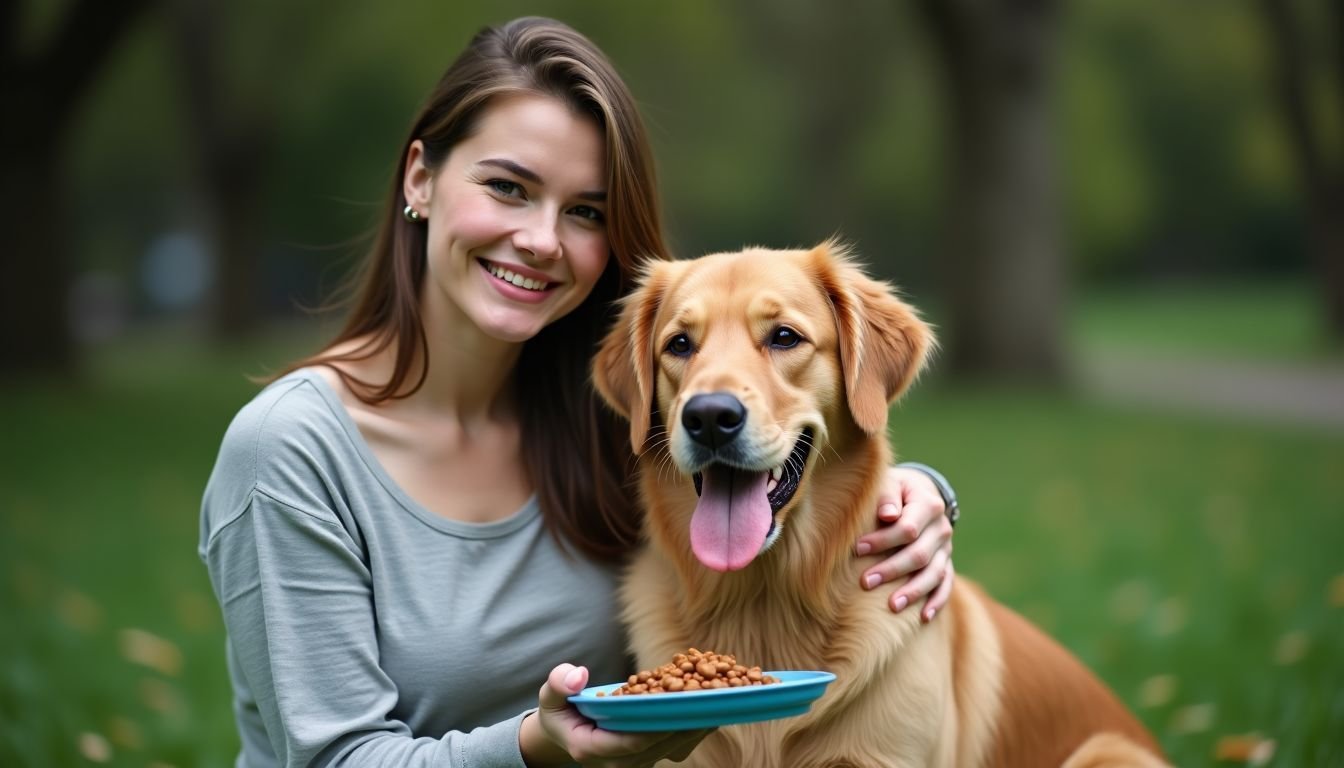
Active dogs need more protein to keep their muscles strong. Want to know which foods pack the most punch? Keep reading!
Performance Dog Food for working and sporting breeds.
I’ve seen firsthand how performance dog food can make a big difference for working and sporting breeds. These active pups need more fuel than your average couch potato. That’s why I always recommend high-protein, high-fat options packed with quality ingredients.
Look for foods with real meat as the first item listed. Chicken, beef, or fish are all great choices. You’ll also want to see healthy carbs like sweet potatoes or brown rice to provide lasting energy.
For my border collie, I use a performance kibble with 30% protein and 20% fat. It keeps her going strong during long days of herding. The extra calories and nutrients support her lean muscle mass and quick recovery.
I’ve noticed she has more stamina and focus since switching. Just be careful not to overfeed – even active dogs can pack on pounds if given too much. Adjust portions based on your dog’s specific needs and activity level.
High-Protein Dog Food for muscle development.
I’ve observed how high-protein dog food can significantly improve muscle growth in dogs. These foods contain quality meat sources like chicken, beef, or fish. They’re beneficial for active dogs or those needing to increase muscle mass.
My dog showed remarkable improvement on a high-protein diet, gaining lean muscle mass within a few months.
The protein content isn’t the only important factor. Effective muscle-building dog foods also incorporate healthy fats and complex carbohydrates. These provide dogs with the energy needed for exercise and muscle development.
I always check the label for omega-3s as well. They help reduce inflammation and support overall health. Each dog has unique needs. Consult with your veterinarian before making significant changes to your dog’s diet.
Limited Ingredient Dog Food for Allergies

Limited ingredient dog food can be a game-changer for pups with allergies. It cuts out common triggers, giving your furry friend relief from itchy skin and tummy troubles. Want to know more about how this special chow can help your allergic pooch? Keep reading!
Limited Ingredient Diets to reduce allergens.
I’ve seen firsthand how limited ingredient diets can be a game-changer for dogs with allergies. These special foods cut out common triggers like chicken, beef, or grains. They use just a few key ingredients, often with a single protein source like lamb or fish.
This simple approach makes it easier to pinpoint what’s causing your pup’s itchy skin or tummy troubles.
In my experience, many dogs thrive on these stripped-down diets. They’re not just for allergy-prone pooches either. Some pet parents choose them to avoid potential food sensitivities before they start.
The best part? You don’t have to sacrifice quality. Many limited ingredient foods still pack in the nutrients your dog needs, just without the extras that might cause issues. It’s like giving your furry friend a fresh start with their diet.
Hypoallergenic Dog Food for sensitive dogs.
I’ve found that hypoallergenic dog food can significantly improve the well-being of pups with sensitive digestive systems. These specialized formulas contain fewer components, often excluding common allergens such as wheat, soy, or beef.
They’re ideal for dogs experiencing skin irritation, digestive discomfort, or other allergy symptoms from standard kibble. I often suggest pet parents consider foods with unique proteins like duck or salmon, which are less prone to triggering reactions.
It’s also wise to verify the AAFCO statement on the packaging to ensure the food meets nutritional standards.
When selecting a hypoallergenic food, I prioritize high-quality proteins and easily digestible carbohydrates like sweet potatoes. Some excellent choices include limited ingredient diets or grain-free options.
These foods frequently contain added omega-3s for skin health and probiotics for digestive support. Each dog is unique, so finding the ideal food may require some experimentation. It’s crucial to consult with your veterinarian before implementing significant dietary changes, particularly if your canine companion has health concerns.
Best Puppy Food for Growing Pets
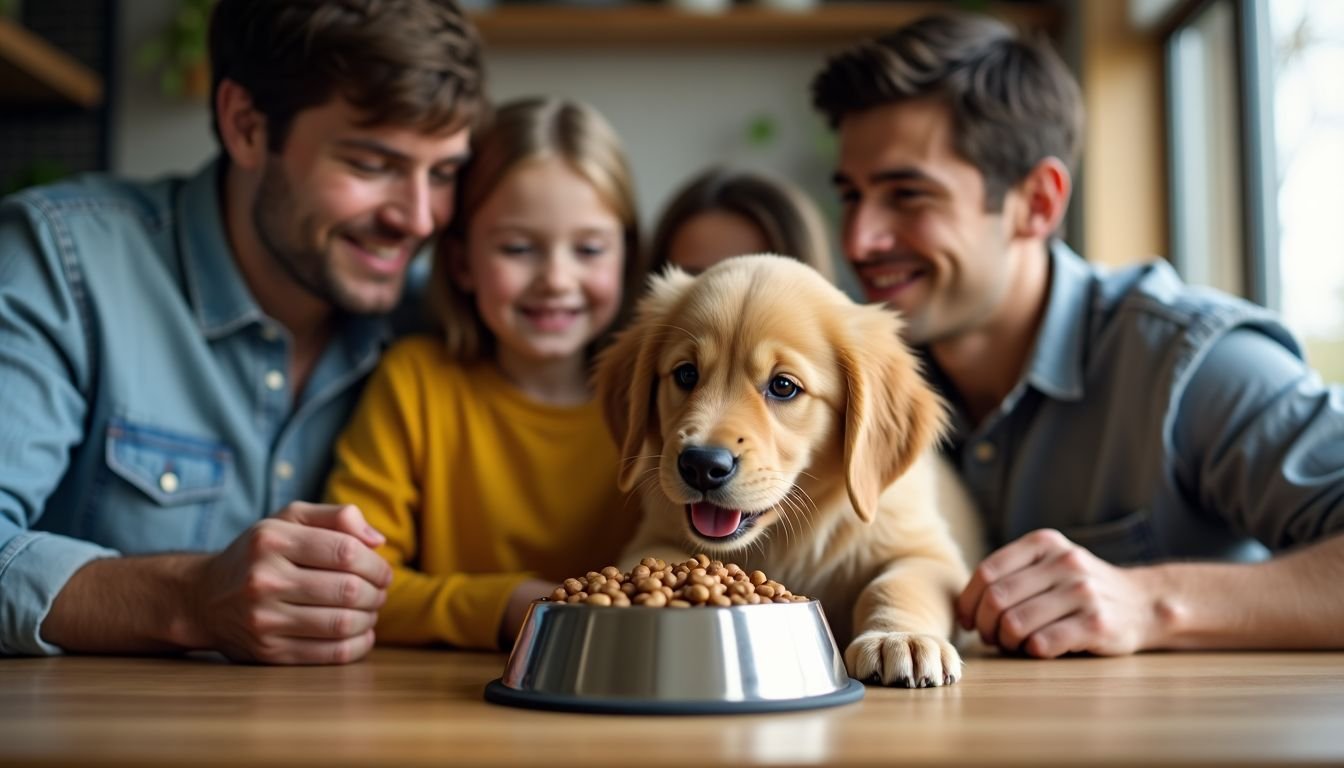
Puppies need special food to grow big and strong. I’ve found some great options that’ll make your pup’s tail wag. Want to know more? Keep reading!
Puppy-Specific Nutrition for growth and development.
I’ve learned that puppy food is a big deal for growing dogs. It’s packed with extra nutrients they need to grow strong and healthy. Puppy chow has more protein, fat, and calories than adult dog food.
This helps them build muscle, grow bones, and have energy to play all day.
Good puppy food also has DHA, an omega-3 fatty acid. It’s great for brain and eye growth. I make sure to pick food with high-quality meat as the first ingredient. Chicken, beef, or fish are all good choices.
I avoid foods with lots of fillers or artificial stuff. Natural ingredients are the way to go for my little furball’s best start in life.
High-Calorie Puppy Food for healthy weight gain.
Now that we’ve covered puppy-specific nutrition, I’ll talk about high-calorie puppy food. Growing pups need lots of energy, and sometimes they need extra help to gain weight. That’s where high-calorie puppy food is useful.
I’ve observed many thin pups develop into healthy, robust ones with the right food. High-calorie puppy chow contains more nutrients in each bite. It’s rich in beneficial fats and proteins to help build strong muscles.
Some brands even include special oils for a shiny coat. Just keep in mind, excessive amounts of a beneficial item can be detrimental. Always consult with your vet before changing to high-calorie food.
They’ll assist you in finding the ideal balance for your furry friend’s needs.
Senior Dog Food for Aging Dogs

As our furry friends age, their needs change. Senior dog food helps keep them healthy and active. Want to know more about the best options for your older pup?
Senior Dog Food with Joint Support.
I’ve seen firsthand how the right food can make a world of difference for older dogs. Senior dog food with joint support is a game-changer for our aging pals. These special blends pack a punch with glucosamine and chondroitin, which help keep those old bones moving smoothly.
I’ve noticed my 12-year-old Lab perking up after switching to this type of food.
But it’s not just about joints. These foods often have lower calories to help manage weight, which is crucial for senior dogs. They’re also easier to digest, which is a big plus for older tummies.
I always look for omega-3 fatty acids on the label too. They’re great for brain health and can keep that senior dog spark alive. It’s amazing how the right mix of nutrients can help our furry friends stay frisky well into their golden years.
Easier-to-Digest Senior Dog Food for older dogs.
As our furry friends age, their tummies can get a bit fussy. That’s why I always recommend easier-to-digest senior dog food for older pups. These special chows often have softer kibble or wet food options that are gentler on aging teeth and gums.
They’re packed with high-quality proteins that are easy to break down, like chicken or fish. Plus, they usually contain extra fiber to keep things moving smoothly in the digestive tract.
Senior dog food also tends to have fewer calories and less fat than regular adult dog food. This helps keep older dogs at a healthy weight, which is key for their joint health. Many brands add glucosamine and omega-3 fatty acids to support those creaky joints and keep coats shiny.
I’ve found that these foods can really perk up an older dog’s energy levels and overall health. It’s like giving them a tasty fountain of youth in every bowl!
Food for Dogs with Sensitive Stomachs
Dogs with tummy troubles need special chow. I’ve seen pups bounce back with the right grub. Want to know more about keeping your furry friend’s belly happy? Keep reading!
Easily Digestible Dog Foods for gastrointestinal issues.
I’ve observed how the right food can help dogs with tummy troubles. Digestible dog foods are beneficial for pups with sensitive stomachs. These diets often use simple ingredients that are gentle on the gut.
They include lean proteins like chicken or fish, and easy-to-process carbs such as rice or sweet potatoes. Many brands also add probiotics to support digestive health.
When selecting food for a dog with GI issues, I always check the label. I look for high-quality proteins and avoid fillers or artificial additives. Some good options include foods with pumpkin, which can soothe upset tummies.
Omega-3 fatty acids are another benefit, as they can reduce inflammation in the gut. Each dog is unique. What works for one might not work for another. It’s good to try a few options and see what sits well with your furry friend.
Probiotic-Enriched Dog Food for digestive health.
I’ve noticed many dogs experiencing digestive issues. That’s why I favor probiotic-enriched dog food. These specialized foods contain beneficial bacteria that support your dog’s digestive health.
They function by enhancing the helpful microorganisms in your dog’s digestive system, aiding digestion and promoting regular bowel movements.
The benefits extend beyond addressing digestive discomfort. Probiotic dog food can strengthen your pet’s immune system. It enhances nutrient absorption and may even positively affect their mood.
I suggest looking for foods containing live cultures such as Lactobacillus or Bifidobacterium. These microorganisms can significantly impact your dog’s overall well-being. I always recommend consulting with your veterinarian before making significant changes to your dog’s diet, as each dog has unique needs.
Weight Management Dog Food for Overweight Pets
If your pup’s waistline is expanding, it’s time to check out some weight management dog food. These special chow options can help your furry friend slim down without feeling hungry.
Want to know more about keeping your pooch fit and healthy? Keep reading!
Low-Calorie Dog Food for weight control.
I’ve got a tip for you: low-calorie dog food can be very effective for pups carrying extra pounds. These special chows pack fewer calories per serving, helping your furry friend slim down without feeling hungry.
Many brands offer tasty options that still meet AAFCO guidelines, so your dog gets all the good stuff they need to stay healthy.
Here’s an important point – it’s not just about cutting calories. The best weight control foods also have extra protein and fiber to keep your pup feeling full. Some even include omega-3s for that shiny coat.
Just keep in mind, portion control is key! Speaking of control, another way to keep your dog’s weight in check is high-protein, low-carb dog food for satiety.
High-Protein, Low-Carb Dog Food for satiety.
I’ve found that high-protein, low-carb dog food works wonders for keeping pups full. It’s packed with meat and light on grains, which mimics a dog’s natural diet. This combination helps dogs feel satisfied longer, so they’re less likely to beg for more food.
My own pooch used to eat constantly until I switched him to this type of chow. Now he’s content after meals and maintains a healthy weight. The best part? These foods often use quality protein sources like real chicken or fish.
They’re also loaded with beneficial ingredients like omega-3s for a shiny coat. It’s a good idea to check the label for the AAFCO statement to make sure it meets nutritional standards.
Joint Health Dog Food with Glucosamine
I’ve seen dogs bounce back from joint issues with the right food. Glucosamine-rich chow can work wonders for creaky pups. Want to learn more about keeping your furry friend spry? Keep reading!
Glucosamine-Enriched Dog Food for joint support.
I’ve seen firsthand how glucosamine-enriched dog food can help pups with joint issues. My old Lab, Max, started limping at age 10. His vet suggested a switch to food with glucosamine.
Within weeks, Max was moving easier. These special foods have extra glucosamine and chondroitin. These nutrients help build and repair joint cartilage. They also reduce inflammation.
Many brands now offer this type of food for older or arthritic dogs.
Not all joint-support foods are equal though. I always check the label for high-quality protein sources. Brown rice, sweet potatoes, and fish oil are good extras to look for too. The AAFCO statement is key – it tells you if the food meets nutritional standards.
For active breeds or working dogs, high-protein options with joint support can be great. They help maintain muscle while protecting joints. Always talk to your vet before making big diet changes, especially for dogs with health issues.
Omega-3 Fatty Acid-Rich Dog Food for mobility.
Moving from joint support to overall mobility, I’ve found that omega-3 fatty acids play a key role. These healthy fats do wonders for our furry friends. They help reduce inflammation and keep joints flexible.
I’ve seen firsthand how dogs with stiff joints perk up after switching to omega-3 rich foods.
Fish-based dog foods are a great source of these fats. Salmon, in particular, packs a punch. It’s not just good for mobility, but also for skin and coat health. I always look for foods with real fish as the first ingredient.
The AKC backs this up, listing omega-3s as a healthy extra to seek out in dog food. For active pups or older dogs, these foods can make a big difference in their daily lives.
Skin and Coat Health Dog Food with Omega-3
I love seeing my dog’s coat shine. Omega-3 rich foods can work wonders for your pup’s skin and fur. Want to know more about keeping your furry friend looking their best? Keep reading!
Salmon and Fish Oil-Based Dog Food for a shiny coat.
I’ve seen firsthand how salmon and fish oil-based dog food can work wonders for a pup’s coat. These foods are packed with omega-3 fatty acids, which are key for healthy skin and a glossy coat.
My own dog’s fur became noticeably shinier after switching to a salmon-based diet. The omega-3s help reduce inflammation and keep the skin moisturized, leading to less shedding and a softer feel.
Many top brands now offer salmon or fish oil options. They often include other good stuff like sweet potatoes and cranberries too. These extras provide more nutrients that support overall health.
When picking a food, I always check the label for high-quality protein sources and avoid fillers. It’s amazing how the right food can make such a big difference in a dog’s appearance and well-being.
Omega-6 Fatty Acids for healthy skin.
I’ve observed how omega-6 fatty acids can improve a dog’s skin. These fats help maintain your pup’s coat shine and skin health. Omega-6 is present in many dog foods, often sourced from chicken fat or vegetable oils.
It’s essential to find a balance of omega-6 and omega-3 fats in your dog’s diet.
Excessive omega-6 can lead to inflammation, so moderation is crucial. I always review the label to ensure a good mix of fats. Some excellent sources of omega-6 include sunflower oil and safflower oil.
When combined with omega-3s from fish oil, these fats can significantly enhance your dog’s skin health. Keep in mind that each dog is unique, so what’s effective for one might not be for all.
Probiotic-Enriched Dog Food for Digestive Health
Probiotic-enriched dog food can work wonders for your pup’s tummy troubles. These special chow options pack a punch of good bacteria. They help keep your furry friend’s gut happy and healthy.
Want to learn more about how these foods can boost your dog’s digestive health? Keep reading!
Probiotics for Dogs for better gut health.
I’ve seen firsthand how probiotics can work wonders for a dog’s gut health. These tiny helpers are like a superhero squad for your pup’s tummy. They fight off bad bacteria and keep things running smoothly in the digestive system.
I always look for dog food with added probiotics when shopping for my furry friend. It’s an easy way to boost their overall health without any extra effort.
Probiotics aren’t just a fad. They’re backed by science and recommended by vets. I’ve noticed my dog has more energy and fewer tummy troubles since switching to probiotic-rich food.
It’s like giving their gut a daily tune-up. Plus, a healthy gut means a stronger immune system. That’s a win-win in my book. If you want to give your dog’s health a boost, probiotic dog food is a great place to start.
Prebiotic Dog Food for digestive balance.
Now that we’ve covered probiotics, let’s talk about prebiotics. These are special fibers that feed the good bacteria in your dog’s gut. Prebiotic dog food helps keep your pup’s tummy happy and balanced.
It’s like giving the good bugs in their belly a tasty meal.
I’ve found that prebiotic-rich foods can really boost a dog’s overall health. They help with nutrient absorption and can even strengthen the immune system. Some great prebiotic sources for dogs include sweet potatoes, peas, and oatmeal.
These ingredients are often found in high-quality dog foods. When picking a prebiotic dog food, I always check the label for these wholesome extras.
Organic and Natural Dog Food Options
I love giving my pup organic chow made from fresh, natural stuff. It’s like serving up a gourmet meal for my furry friend! Want to know more about the best organic options out there?
Organic Dog Food made with fresh, natural ingredients.
I’ve seen a big shift in dog food lately. More folks want organic chow for their pups. It’s made with fresh, natural stuff. No fake colors or weird preservatives here. Just good, wholesome ingredients that dogs love.
I’ve tried it with my own furry friend, and boy, does he gobble it up!
Organic dog food often has real meat, veggies, and fruits. Think chicken, sweet potatoes, and blueberries. These foods pack a punch of nutrients. They help keep dogs healthy from nose to tail.
Plus, they’re easier on sensitive tummies. I’ve noticed my dog’s coat looks shinier since we switched. It’s like he’s got a new spring in his step!
Whole Foods-Based Dog Food with no artificial additives.
I’m a big fan of whole foods-based dog food. It’s packed with natural ingredients and skips the fake stuff. These foods use real meat, veggies, and fruits that dogs can easily digest.
They’re full of nutrients your pup needs to stay healthy and happy. Plus, they don’t have any weird chemicals or colors that might upset your dog’s tummy.
When I pick a whole foods dog food, I look for ones with meat as the first ingredient. Good choices include chicken, beef, or fish. I also check for healthy carbs like sweet potatoes or brown rice.
Fruits and veggies add extra vitamins and fiber. The best part? These foods often have omega fatty acids for a shiny coat. Your dog will love the taste, and you’ll love knowing they’re eating real, good food.
Raw and Freeze-Dried Dog Food Options
Raw and freeze-dried dog food options are gaining popularity among pet owners. These diets aim to mimic a dog’s natural eating habits in the wild. They often contain high-quality proteins and fewer preservatives.
Some pet parents swear by the benefits, like shinier coats and better digestion. Want to know if it’s right for your furry friend? Keep reading to learn more about these trendy food choices!
Raw Dog Food Diets for natural feeding.
I’ve tried raw dog food diets, and I’m a fan. They’re all about giving your pup food that’s close to what they’d eat in the wild. Think uncooked meat, bones, fruits, and veggies. The idea is that it’s more natural and healthy for dogs.
Many pet owners say their dogs have shinier coats and more energy on these diets.
But raw diets aren’t for every dog. They need careful planning to make sure your pet gets all the right nutrients. It’s also key to handle raw meat safely to avoid any health risks.
I always tell folks to chat with their vet before making big changes to their dog’s diet. After all, every pup is unique and has different needs.
Freeze-Dried Raw Dog Food for convenience.
Freeze-dried raw dog food is a game-changer for busy pet owners like me. I’ve found it’s a great way to give my pup the benefits of raw food without the mess or hassle. The process keeps all the good stuff in – proteins, vitamins, and minerals – while making it super easy to store and serve.
No more thawing or prepping raw meat! I just scoop out what I need and add water. It’s lightweight too, which makes it perfect for trips or camping with my furry friend.
I’ve noticed my dog loves the taste of freeze-dried raw food. It’s like a treat to him, but it’s actually a full meal. The best part? I don’t have to worry about spoilage or bacteria growth like with regular raw food.
This stuff can sit on my shelf for months. Plus, it’s packed with high-quality protein and doesn’t have any fillers or artificial junk. For me, it’s the perfect mix of nutrition and convenience.
High-Calorie Dog Food for Puppies or Working Dogs
Puppies and working dogs need extra fuel to grow and perform. High-calorie chow packs a punch, giving them the energy they need. Want to know which brands are top dog? Keep reading!
Calorie-Dense Dog Food for puppies and high-energy dogs.
I love feeding my pups calorie-dense dog food. It’s perfect for growing puppies and active dogs who need extra fuel. These foods pack more calories per cup, so my furry friends get the energy they need without eating huge amounts.
I look for options with high-quality protein sources like chicken or beef. They help build strong muscles. I also make sure the food has healthy fats for energy and brain development.
For my high-energy dogs, I pick performance formulas made for working breeds. These have extra protein and fat to keep up with their active lifestyles. Some even add supplements like glucosamine for joint health.
The best part? My dogs love the taste of these nutrient-rich foods. It’s a win-win – they get the calories they need and enjoy every bite.
Performance Dog Food for active breeds.
Now that we’ve covered high-calorie food for puppies, let’s talk about performance dog food for active breeds. As a dog owner with a lively Border Collie, I know how crucial the right food is for energetic pups.
Performance dog food contains higher levels of protein and fat. It provides energy for working dogs, athletes, and high-energy breeds. These foods often have 30% or more protein and up to 20% fat.
They also include complex carbs for sustained energy. I’ve noticed a significant improvement in my dog’s stamina since switching to this type of food. Consider options with real meat as the first ingredient and healthy additions like omega fatty acids.
Keep in mind that this food isn’t suitable for every dog – it’s most appropriate for those expending a lot of energy daily.
Dental Health Dog Food for Cleaner Teeth
I love giving my dog dental chews to keep his teeth clean. These tasty treats scrape away plaque while he chews. Want to learn more about keeping your pup’s pearly whites healthy? Keep reading!
Dental Chews for plaque and tartar control.
Dental chews are a game-changer for keeping your dog’s teeth clean. I’ve seen firsthand how these treats can work wonders. They’re like toothbrushes for dogs, but way more fun. As your pup chews, the texture scrubs away plaque and tartar.
It’s like giving them a mini dental cleaning every time they snack.
But not all chews are created equal. Look for ones with the Veterinary Oral Health Council (VOHC) seal. These have been tested and proven to work. Some even have special enzymes that break down bacteria.
My dog loves the ones shaped like little toothbrushes. They’re a tasty way to keep those pearly whites shining. Next up, let’s talk about tartar control dog food and how it can help your pup’s smile.
Tart Control Dog Food for dental hygiene.
I’ve found that tart control dog food can work wonders for my pup’s teeth. These special kibbles have a unique texture that scrubs away plaque as my dog chews. They often contain ingredients like sodium hexametaphosphate that bind to calcium in saliva, stopping tartar from forming.
Some brands even add natural breath fresheners like parsley or mint. While not a replacement for brushing, this type of food helps keep my dog’s mouth cleaner between dental visits.
Next up, let’s wrap things up with some final thoughts on choosing the best food for your furry friend.
Conclusion
I’ve covered a lot about dog food. It’s clear that picking the right chow for your pup matters. Let’s hear from an expert on this topic.
Dr. Sarah Barker is a vet with 20 years of experience. She’s written books on pet nutrition and runs a popular dog health blog. Dr. Barker says, “The best dog food depends on your pet’s needs.
Look at age, size, and health issues. Always check the label for quality ingredients.”.
She adds, “Safety is key. Choose brands that follow FDA rules. Avoid foods with mystery meats or too many fillers. Transparency is vital in the pet food world.”.
Dr. Barker suggests, “Mix it up. Rotate between wet and dry food. This gives your dog different nutrients and keeps meals exciting.”.
On pros and cons, she notes, “Premium foods cost more but often have better ingredients. Cheaper foods might fill your dog up, but may lack nutrients. Balance is crucial.”.
Dr. Barker’s final take? “There’s no one perfect food for all dogs. Know your pet’s needs, read labels, and don’t be afraid to try new options. Your vet can help guide you. Happy feeding!
FAQs
1. What’s the scoop on sensitive stomach dog food?
Sensitive stomach dog food is a lifesaver for pups with delicate tummies. It’s packed with easy-to-digest ingredients and often includes probiotics for better digestion. These chow options are typically low in fat and rich in fiber, helping Fido’s gut stay happy and healthy.
2. How can I pick the best grub for my furry friend’s skin?
For canine skin health, look for chow with omega-3 and omega-6 fatty acids. These nutrients are key for a shiny coat and healthy skin. Anti-inflammatory dog food can also work wonders for skin conditions. Don’t forget about hydrating options if your pooch has dry skin!
3. What’s the deal with grain-free wet dog food?
Grain-free wet dog food is a hit with picky eaters. It’s often packed with high-quality protein and natural ingredients. This type of grub can be great for dogs with certain allergies. But remember, not all pups need to go grain-free. Chat with your vet before making the switch.
4. How do I choose the right chow for my senior dog?
For older pooches, look for food that supports immune health and joint function. Chow with glucosamine can help keep those joints spry. Antioxidant-rich options are great for overall health. And don’t forget about dental chews to keep those pearly whites in top shape!
5. What should I feed my working dog or athletic pup?
High-energy dogs need calorie-dense food to keep up with their active lifestyle. Look for options high in protein to help build and maintain lean muscle mass. Some working dogs might benefit from high-fat food for weight gain and sustained energy. It’s all about matching the fuel to the engine!
6. How can I help my overweight dog slim down?
For chubby pups, low-calorie food is the way to go. Look for options high in fiber to help your dog feel full. Wet food can be a good choice as it’s often less calorie-dense than dry kibble. And don’t forget, exercise is key! A brisk walk can work wonders for both you and your furry friend.
editor's pick
latest video
news via inbox
Nulla turp dis cursus. Integer liberos euismod pretium faucibua

